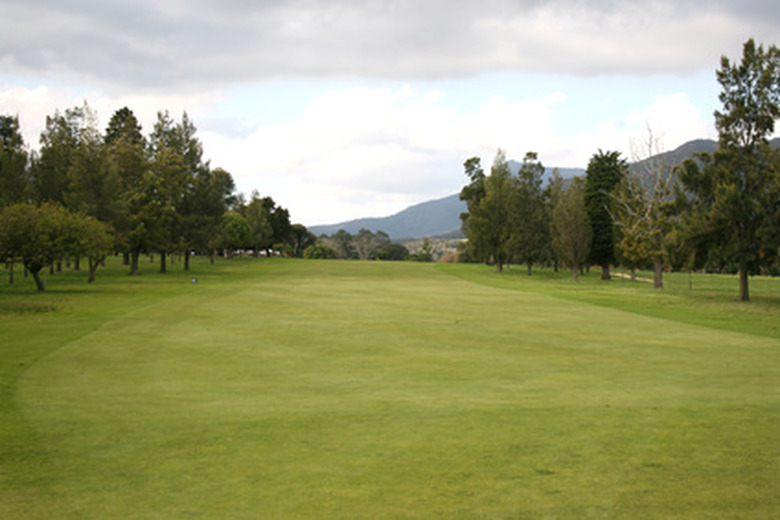Bermuda Grass & Sand
Bermuda grass (Cynodon spp.) originated in eastern Africa and was brought into the United States in the 1750s to use as a forage grass for cattle, dune stabilization and short road and lawn grass in warm climates. Unless managed in a pristine lawn area, many gardeners regard Bermuda grass' aggressive roots and ability to re-seed as an annoying garden weed. Other common names for this grass include couchgrass, devilgrass, wiregrass or dogtooth grass. Bermuda grass is appropriate for U.S. Department of Agriculture hardiness zone 6 through 11 that have the mildest winter temperatures.
Types
Common Bermuda grass is identified botanically as Cynodon dactylon. Modern hybrid types are derived from crossing that species with Cynodon transvaalensis, according to Texas A&M University. Today there are many varieties of Bermuda grass available for gardeners, including cultivars such as Tifgreen, Ormond, Tifway and Peedee. Sunturf (Cynodon magennissii) is the common name of another species of Bermuda grass most commonly grown as turf in the American Southwest.
- Bermuda grass (Cynodon spp.)
- Sunturf (Cynodon magennissii) is the common name of another species of Bermuda grass most commonly grown as turf in the American Southwest.
Soil Needs
Bermuda grasses grow successfully on sand, loam and clay soils as long as they have good drainage, never become soggy and provide a high amount of nitrogen. Although remarkably drought tolerant, Bermuda grass goes partially dormant and browns in extremely dry conditions. Blue Plant Biomes lists that the rhizome roots in drought grow as deeply as 60 inches for moisture. This reference also mentions that this grass needs irrigation in regions where less than 16 inches of rain falls annually.
Sandy Soil Features
According to Robert Black and Gary Knox in "Your Florida Landscape," it's sand's physical properties that pose plant growth and lawn management problems. Sandy soils drain quickly after rains or irrigation and thus dry out faster than a loam or clay soil. Moreover, fertilizers or organic material nutrients leach through sand particles faster because of the coarse, loose texture. Black and Knox also mention that using water-soluble fertilizer in sandy soils is bad practice, since it so quickly drains away out of reach for the surface-dwelling plant roots.
- Bermuda grasses grow successfully on sand, loam and clay soils as long as they have good drainage, never become soggy and provide a high amount of nitrogen.
- Blue Plant Biomes lists that the rhizome roots in drought grow as deeply as 60 inches for moisture.
Watering Considerations
Bermuda grass roots grow deeper than 6 inches in sandy soil to seek out moisture. The need for water for optimum grass growth is highest for golf course green and athletic fields. Water needs are intermediate for home lawns, and lowest for roadside berm erosion areas.
In summer, Bermuda grass needs 1/10 to 1/3 inch of water daily to sustain itself. Providing an irregular, deep watering to a depth of 6 inches is best, rather than ligthly watering every day. Overall, although highly drought tolerant, Bermuda grass responds well with summer growth when irrigated or rainfall supplies 1 inch of water every three to seven days.
Fertilizer Insight
Black and Knox recommend using granular, slow-release fertilizers in sandy soils. Leaching is reduced, especially if some clipping debris remains to decompose and improve the fertility under the Bermuda grass lawn.
- Bermuda grass roots grow deeper than 6 inches in sandy soil to seek out moisture.
- Overall, although highly drought tolerant, Bermuda grass responds well with summer growth when irrigated or rainfall supplies 1 inch of water every three to seven days.
Sandy soils need light but frequent applications of nitrogen because of leaching. Sandy soils are also typically low in other nutrients such as phosphorus and potassium.
Conduct a soil test to learn exactly which nutrients are lacking in a sandy soil. Texas A&M University notes that common Bermuda grass has a slightly less need for fertilizer than modern hybrid varieties. In general, apply between 1/2 and 1 lb. of nitrogen per 1,000 square feet of grass each month during the growing season on Bermuda grasses.
What is "Sanding?"
In clay soils, a process called "sanding" is employed to improve root growth of Bermuda grasses or to level out holes or strange depressions across an even surface. First the soil is aerated and then sand scattered across the turf to collect in the aeration pores in the soil. An alternative to using sand after aeration is to scatter fine-particle compost or other organic matter. This matter allows for water drainage and provides nutrients to roots.
- Sandy soils need light but frequent applications of nitrogen because of leaching.
- In clay soils, a process called "sanding" is employed to improve root growth of Bermuda grasses or to level out holes or strange depressions across an even surface.
References
- "Your Florida Landscape"; Robert J. Black and Kathleen C. Ruppert, eds.; 1998
- Texas A&M University (Aggie Horticulture): Bermudagrass
- Blue Planet Biomes: Bermuda Grass
- University of California Statewide IPM Program: Bermudagrass
